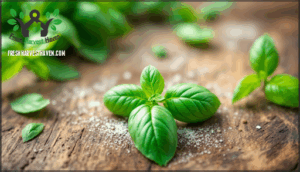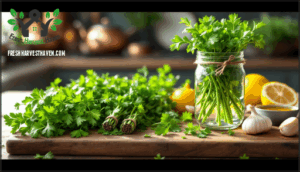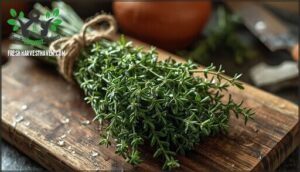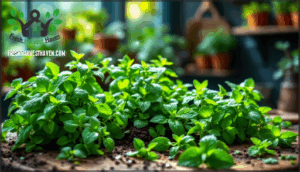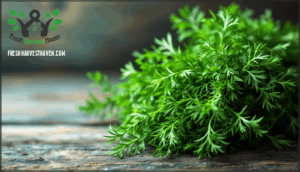This site is supported by our readers. We may earn a commission, at no cost to you, if you purchase through links.
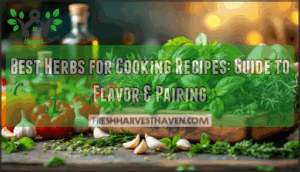 The difference between a bland dish and one that makes people reach for seconds often comes down to a handful of green leaves. Fresh herbs transform ordinary recipes into memorable meals, yet many home cooks stick to the same two or three options simply because they don’t know where to start.
The difference between a bland dish and one that makes people reach for seconds often comes down to a handful of green leaves. Fresh herbs transform ordinary recipes into memorable meals, yet many home cooks stick to the same two or three options simply because they don’t know where to start.
Each herb carries distinct flavor compounds that can brighten, deepen, or completely redirect a dish’s profile. Understanding which herbs work best in different cooking scenarios—and how to pair them effectively—gives you a culinary toolkit that rivals any expensive spice collection.
The right herb at the right moment can reduce your reliance on salt, add complexity to simple ingredients, and make even weeknight dinners feel special.
Table Of Contents
- Key Takeaways
- Essential Herbs for Everyday Cooking
- Basil – Sweet and Savory Uses
- Parsley – Universal Garnish and Flavor
- Rosemary – Robust and Woody Aromatic
- Thyme – Versatile and Fragrant
- Cilantro – Bright and Citrusy
- Mint – Freshness in Sweet and Savory Dishes
- Oregano – Mediterranean and Mexican Favorite
- Sage – Earthy and Hearty Applications
- Dill – Grassy and Distinctive Flavor
- Chives – Mild Onion Notes
- Fresh Vs. Dried Herbs in Recipes
- Classic Herb Pairings and Flavor Combinations
- Proper Storage and Preservation of Herbs
- Cooking Tips and Herb-Focused Recipes
- Frequently Asked Questions (FAQs)
- Which herbs are safest for children and pets?
- How to grow herbs indoors in small spaces?
- Can all herbs be eaten raw in recipes?
- What herbs pair well with seafood dishes?
- Are there herbs that can trigger allergies?
- Which herbs grow best in indoor gardens?
- Can pregnant women safely consume all herbs?
- Which herbs help with digestive issues naturally?
- How do herbs interact with medications?
- What herbs are toxic to pets?
- Conclusion
Key Takeaways
- Fresh herbs deliver 80–90% water and volatile oils that fade under heat, making them ideal for finishing dishes or raw preparations, while dried herbs concentrate essential oils three to four times stronger—perfect for slow-cooked applications where their heat-stable compounds infuse deeply over extended cooking times.
- The standard conversion ratio of 3:1 (one tablespoon fresh equals one teaspoon dried) applies to most flaky herbs like basil and thyme, but woody varieties and delicate herbs require adjustments, and ground herbs demand a 4:1 ratio due to their concentrated flavor from fine grinding.
- Classic herb combinations define entire cuisines—Italian cooking relies on basil, oregano, and parsley for tomato-based dishes, while French traditions use thyme, tarragon, and chives to enhance delicate sauces, and Mexican flavors depend on cilantro’s citrus brightness paired with oregano’s peppery depth.
- Strategic herb use reduces sodium needs by 25–50% without sacrificing taste, as aromatic compounds and natural glutamates in rosemary, thyme, and sage provide flavor complexity that retrains your palate within six to eight weeks while supporting cardiovascular health.
Essential Herbs for Everyday Cooking
A well-stocked kitchen starts with herbs that work across different recipes and cooking styles. The right herbs can transform simple ingredients into memorable meals, whether you’re preparing weeknight dinners or experimenting with new flavors.
Here are ten essential herbs that belong in every cook’s arsenal.
Basil – Sweet and Savory Uses
Basil varieties are preeminent in Italian cuisine, offering sweet, peppery notes that transform simple dishes into memorable meals. Sweet basil accounts for over 70% of global production, and you’ll find it bringing bright, aromatic character to everything from fresh caprese salads to rich tomato sauces. Basil also offers significant antioxidant benefits that can help protect the body’s cells.
- Pesto variations: Blend fresh basil with pine nuts, garlic, Parmesan, and olive oil for the classic Genovese sauce
- Tomato pairings: Add torn leaves to marinara, Pomodoro, or bruschetta to heighten natural sweetness
- Salad applications: Toss whole or chiffonade-cut basil into green salads, grain bowls, or mozzarella plates
- Infused oils: Steep leaves in warm olive oil to create aromatic bases for dressings and marinades
- Timing matters: Add delicate fresh herbs during the last 1-2 minutes of cooking to preserve volatile oils and flavor dishes without bitterness
Parsley – Universal Garnish and Flavor
While basil brings sweetness to Italian dishes, parsley offers a brighter, grassier foundation across nearly every cuisine. You’ll find flat-leaf varieties delivering cleaner flavor dishes than their curly counterparts, with each cup providing over 820% of your daily vitamin K and powerful antioxidants.
Use fresh herbs as both garnish and primary ingredient in chimichurri, gremolata, or parsley pesto, where its citrusy brightness cuts through rich proteins. Parsley also boasts cancer-fighting substances, making it a healthy addition to any meal.
Storage methods matter—keep bunches upright in water under refrigeration for nearly a month, maintaining those essential health benefits and vibrant herb pairings that improve everyday cooking.
Rosemary – Robust and Woody Aromatic
While parsley brightens dishes with grassiness, rosemary anchors them with woody, pine-like intensity that transforms roasted meats and root vegetables. You’ll extract maximum flavor by pairing this aromatic with garlic, lemon, and thyme—its volatile oils withstand temperatures up to 180°C without losing punch.
One teaspoon of dried rosemary equals roughly one tablespoon fresh, and proper storage in airtight containers preserves those medicinal properties for up to 18 months, supporting the herb’s growing extract market driven by both culinary and wellness applications.
Thyme – Versatile and Fragrant
Where rosemary delivers pine-forward intensity, thyme offers subtler, earthy warmth that works across culinary traditions—from French bouquet garni to Middle Eastern za’atar blends. You’ll find its thymol-rich essential oils withstand extended cooking without bitterness, making it ideal for:
- Long-simmered stews and braises
- Roasted vegetables and poultry
- Marinades and compound butters
Fresh thyme substitutes at a 3:1 ratio for dried, and proper storage in sealed containers preserves flavor chemistry for up to two years while delivering notable health benefits.
Cilantro – Bright and Citrusy
Cilantro divides kitchens like few ingredients can—a genetic link to the OR6A2 gene makes some perceive its fresh herbs as soapy while others embrace its bright, citrusy punch.
You’ll find this polarizing herb anchoring Mexican cuisine staples like salsa and guacamole, where its flavor profiles shine when added raw at service.
Market trends show rising demand as global palates expand, while its health benefits include antioxidant compounds and trace minerals that support cellular function.
Mint – Freshness in Sweet and Savory Dishes
Few ingredients bridge savory and sweet as naturally as mint—you’ll recognize its cooling menthol kick in lamb marinades, Vietnamese pho, and Middle Eastern tabbouleh, while dessert applications span ice creams to mojitos. Mint varieties like peppermint and spearmint offer distinct flavor profiles, with global mint cultivation supplying 70% of the world’s production from U.S. farms.
Market trends show surging demand driven by natural ingredient preferences, and health benefits include antioxidant activity and digestive support, making fresh herbs like mint essential in herb recipes.
Oregano – Mediterranean and Mexican Favorite
Two oregano varieties shape global kitchens: Mediterranean oregano (Origanum vulgare) brings sweet, peppery notes to Italian pizzas and Greek marinades, while Mexican oregano (Lippia graveolens) adds citrus-forward, smoky depth to chili and tamales.
Essential oils containing carvacrol and thymol deliver antimicrobial health benefits and antioxidant activity twice that of fresh forms.
Market trends show the oregano segment reaching $700 million by 2033, driven by Mediterranean cuisine popularity and natural flavoring demands across convenience foods.
Sage – Earthy and Hearty Applications
When you think of sage, picture the quintessential herb for cold-weather comfort food—its earthy, slightly bitter profile transforms rich meats and starchy sides into something memorable. You’ll find this Mediterranean staple particularly useful in four key applications:
- Poultry and pork dishes where its camphor-forward aromatics cut through fatty richness
- Brown butter sauces that highlight sage’s nutty, warming characteristics
- Stuffing and bread-based recipes capitalizing on its traditional Thanksgiving role
- Roasted root vegetables where earthy meets earthy in perfect harmony
Fresh sage delivers a softer, more nuanced flavor when added toward the end of cooking, while dried sage packs a concentrated punch throughout braising or roasting.
Store fresh leaves wrapped in damp paper towels in your crisper for several days, or dry them in airtight containers for six to twelve months of potent seasoning power. Beyond flavoring dishes, sage’s phenolic compounds offer antioxidant benefits and traditional medicinal uses ranging from cognitive support to antibacterial properties.
Dill – Grassy and Distinctive Flavor
You’ll recognize dill by its feathery fronds and grassy, faintly anise-like flavor profile—a signature in pickling brines, Scandinavian gravlax, and eastern European potato salads. This fresh herb pairs naturally with cucumbers, salmon, yogurt-based sauces like tzatziki, and summer squash, while delivering health benefits through vitamin C, manganese, and anti-inflammatory compounds.
Add fresh dill in the final minute of cooking to preserve its volatile flavor chemistry, or toast dill seeds before incorporating them into bread dough.
Store sprigs wrapped in damp paper towels inside a zip-top bag for up to one week, or freeze them directly for six-month preservation without flavor loss.
Chives – Mild Onion Notes
Chives deliver a whisper of onion flavor without the sharpness, making them your go-to fresh herb for finishing dishes that need subtle allium character. Their mild taste pairs with eggs, potatoes, cream cheese, and dairy-based sauces—particularly in French fines herbes blends—while supplying notable vitamin K and antioxidant compounds.
Here’s how to get the most from their culinary potential:
- Add chopped chives in the final minute of cooking to preserve their delicate sulfur-based aromatics
- Pair with dairy ingredients like sour cream, yogurt, or butter for enhanced flavor contrast
- Store wrapped in damp paper towels for 10–14 days refrigerated
- Freeze chopped portions in ice cube trays for four to six months
- Use 10–15 grams per serving to boost both taste and antioxidant intake
The Netherlands and Belgium dominate global chive exports, reflecting their culinary importance across multiple cuisines.
Fresh Vs. Dried Herbs in Recipes
Fresh and dried herbs each bring something different to your cooking, from flavor intensity to timing and technique. Knowing when to reach for one over the other can transform a dish from flat to full of life.
Here’s what you need to understand about both forms and how to use them effectively in your recipes.
Flavor Differences and Best Uses
The spectrum between fresh and dried herbs isn’t just about moisture—it’s about understanding flavor intensity and suitable applications. Fresh herbs carry 80–90% water, producing delicate, bright notes ideal for finishing dishes or raw preparations like pesto and salads. Dried herbs concentrate essential oils three to four times stronger, making them perfect for slow-cooked stews, braises, and marinades where their heat-stable compounds infuse deeply over time.
| Characteristic | Fresh Herbs | Dried Herbs |
|---|---|---|
| Flavor Intensity | Mild, bright, grassy | Concentrated, woody, earthy |
| Optimal Applications | Salads, garnishes, pestos, light sautés | Soups, stews, roasts, baked dishes |
| Aroma Profile | Volatile, delicate, citrusy | Stable, intense, warm |
| Best Timing | End of cooking (1–2 minutes before serving) | Beginning or middle of cooking process |
| Shelf Life | 3–7 days refrigerated | 1–3 years in airtight storage |
When cooking with herbs, match the form to your technique. Fresh basil and cilantro shine in herb and spice combinations where their volatility enhances dish flavor without heat degradation. Dried rosemary and thyme excel in long braises, their full-bodied herb flavor profiles intensifying under sustained temperatures. This cooking guidance transforms your approach: use fresh for immediacy, dried for depth.
Substituting Fresh for Dried Herbs
Understanding conversion ratios transforms your ability to swap fresh herbs for dried herbs with confidence. The baseline is simple: one tablespoon of fresh herbs equals one teaspoon dried—a 3 to 1 ratio that applies to flaky varieties like basil and thyme. Ground herbs pack even more punch, requiring a 4 to 1 conversion due to flavor concentration from fine grinding.
Herb-specific variations matter. Woody herbs like rosemary maintain the standard 3 to 1 guideline, while delicate cilantro and dill lose volatile oils during drying, working better at 2.5 to 1. Bay leaves flip the script entirely—one fresh leaf substitutes for two dried because fresh retains more oils.
| Herb Type | Fresh Amount | Dried Equivalent |
|---|---|---|
| Flaky (basil, thyme, oregano) | 1 tablespoon | 1 teaspoon |
| Ground (ginger, sage) | 1 tablespoon | ¾ teaspoon |
| Delicate (cilantro, dill) | 1 tablespoon | 1¼ teaspoons |
These practical guidelines account for how drying reduces water content from 80–90% down to roughly 10%, concentrating essential oils up to seven times stronger. Nutrient retention stays high—up to 90% of antioxidants survive proper drying—though vitamin C drops 20–40%. When cooking with fresh herbs versus dried herbs, taste as you go since storage age and drying quality affect potency by 15% or more.
Cooking Techniques for Each Form
Once you’ve nailed the conversion ratios, heat sensitivity determines whether your herbs hit the pan early or land on the plate. Dried herbs can handle temperatures above 180°C for over 30 minutes without losing punch, making them ideal for roasting and simmering. Fresh herbs lose up to 60% of their aroma after 45 minutes of heat, so toss basil, cilantro, and parsley in during the final 5–10 minutes to lock in brightness. Hardy rosemary and thyme tolerate extended cooking, but soft greens shine as finishing touches.
Freezing herbs in olive oil preserves 90% of their intensity for six months, while oven drying at 60–70°C retains 80% of essential oils. Flash-freezing beats air exposure—unprotected herbs oxidize and drop 50% of their potency within three months.
| Technique | Best For | Retention |
|---|---|---|
| Late addition (5–10 min) | Basil, parsley, cilantro | 80% aroma compounds |
| Early addition (30+ min) | Rosemary, thyme, sage | 70% essential oils |
| Oil infusion (85–95°C) | Oregano, rosemary | best flavor transfer |
| Freezing in oil (-18°C) | Mint, basil, chives | 90% after 6 months |
| Oven drying (60–70°C) | Thyme, rosemary, oregano | 80% essential oils |
Marinating proteins with herb oils for 30 minutes boosts absorption by 25% compared to direct addition. Combining dried and fresh forms in a 1:2 ratio balances intensity across varying heat durations, letting you extract deep flavor early while finishing with fresh pop.
Nutritional Benefits Comparison
Beyond flavor and technique, your choice between fresh and dried herbs shifts the nutritional profile of every dish. Fresh basil delivers 145% of the daily vitamin K per ounce, while dried basil drops to 43% per tablespoon—vitamin retention takes a hit during dehydration, with vitamin C plummeting over 70% in oregano and peppermint. Yet dried herbs concentrate mineral density and fiber content. Dried parsley packs 1,380 mg of calcium per 100g compared to 138 mg in fresh, and one tablespoon of dried oregano contributes over 3g of fiber versus under 1g fresh. Antioxidant levels stay surprisingly close—both forms of basil clock 1,200 ORAC per ounce—though phenolic compounds can drop up to 50% in dried parsley. Storage stability favors dried: they hold nutritional benefits for one to three years in cool, dark conditions, while fresh herbs lose vitamin C within a week of harvest. Balancing both forms lets you optimize health benefits across culinary applications.
| Nutrient | Fresh Herbs | Dried Herbs |
|---|---|---|
| Vitamin Retention | Higher per gram (especially C, K, A) | 30–70% loss during drying |
| Mineral Density | Lower concentration due to water content | 2–10x higher (iron, calcium, magnesium) |
| Fiber Content | Minimal per typical serving | 2–5x more per gram |
| Antioxidant Levels | 10–40% more polyphenols per gram | Comparable ORAC; varies by drying method |
Classic Herb Pairings and Flavor Combinations
Certain herbs have become inseparable from the cuisines they define, creating flavor profiles that feel both familiar and essential. Understanding these classic pairings helps you build dishes with authentic taste and confidence.
Here’s how different culinary traditions combine herbs to create their signature flavors.
Italian Cuisine – Basil, Oregano, Parsley
These three herbs form the backbone of Italian cuisine, transforming simple ingredients into dishes that have captivated palates for over two millennia. Each brings distinct character while harmonizing beautifully together:
- Basil delivers sweet, peppery notes essential in Pesto alla Genovese and Caprese salad, thriving in warm Mediterranean climates.
- Oregano provides strong, slightly peppery flavor that defines southern Italian pizza sauce and vegetable dishes.
- Parsley adds grassy freshness to pasta, seafood, and risotto across all Italian regions.
- Combined blend creates the foundation for tomato-based sauces and marinades used throughout Italian cooking.
- Storage tip: Use one teaspoon dried herb for every tablespoon fresh to maintain authentic flavor intensity.
French Cooking – Thyme, Tarragon, Chives
French cuisine’s culinary traditions shine through three defining herbs that enhance delicate dishes and sauces. Thyme, tarragon, and chives each bring unique flavors to the table.
You’ll recognize thyme in Herbes de Provence, lending earthy, floral notes to grilled meats and stews throughout cooking. Tarragon brings a subtle anise flavor to Fines Herbes and French sauces like Béarnaise, while chives add a mild onion essence to eggs and cream-based preparations.
These herbs showcase distinct flavor profiles. Add thyme early when cooking with herbs, but reserve tarragon and chives until finishing to preserve their volatile compounds.
Mexican Dishes – Cilantro, Oregano
Cilantro and oregano form the backbone of Mexican cuisine, delivering bold, layered flavor profiles that stand up to chiles and spices. Cilantro arrived with Spanish conquistadors in the 1500s, while Mexican oregano—native to the region—offers citrus-peppery notes distinct from Mediterranean varieties.
- Salsas and guacamole: Fresh cilantro adds bright, citrusy dimension
- Soups and stews: Mexican oregano complements birria and posole
- Tex-Mex favorites: Both herbs define burritos and enchiladas
- Health considerations: Cilantro carries oral allergy syndrome risks; oregano provides antioxidants
- Regional sourcing: Fresh cilantro preferred over dried; Mexican oregano retains flavor when dried
Mediterranean Flavors – Rosemary, Sage, Dill
Rosemary, sage, and dill anchor Mediterranean cooking with herbs that withstand heat and time. Rosemary appears in 78% of grilled lamb and chicken recipes, delivering piney intensity that survives high-temperature roasting. Sage’s earthy profile dominates 59% of pork dishes, while dill’s grassy brightness enhances 68% of Levantine fish preparations.
| Herb | Flavor Intensity | Best Mediterranean Pairings |
|---|---|---|
| Rosemary | High (maintains at 200°C) | Lamb, focaccia, roasted vegetables |
| Sage | Medium-high | Pork, poultry, stuffing |
| Dill | Delicate | Fish, pickles, yogurt sauces |
| Dried Rosemary | Moderate (6-month shelf life) | Stews, marinades |
| Fresh Dill | Bright (81% fresh usage) | Salads, tzatziki |
For herb preservation, store fresh rosemary in damp towels at 4°C for 14 days. Freeze dill immediately after washing to retain 91% of volatile oils. Sage characteristics hold through refrigeration for two weeks or freezing for six months, making these herbs reliable year-round.
Herb Blends and Compound Butters
Premixed herb blends and herb-infused butter deliver flavor pairing shortcuts for home cooks, with the U.S. seasoning blends market forecast to reach $10.8 billion by 2030. Compound herb butter appears in 42% of grilled steak applications, combining butter pairings with minimal sodium content—under 1 mg per serving in most blends.
- Herbs de Provence uses thyme, rosemary, and lavender in 87% of commercial formulations for roasted meats
- Parsley-chive butter dominates 35% of food blog mentions for warm bread and grilled vegetables
- Dried herb combinations offer 12-month shelf life and command 10–22% price premiums over single herbs
- Culinary applications span marinades to finishing touches, with specialty butter sales up 14% in 2024
Proper Storage and Preservation of Herbs
Fresh herbs lose their vibrancy quickly if you don’t store them properly, so knowing the right techniques makes a real difference in your kitchen. The way you clean, store, and preserve your herbs determines how long they’ll maintain their flavor and aroma.
Here’s what you need to know to keep your herbs at their peak from market to plate.
Cleaning Fresh Herbs for Cooking
Before your herbs hit the pan, cleaning them properly strips away dirt, bacteria, and pesticide residue that cling to delicate leaves. Gently swish fresh herbs in cool water—studies show this removes up to 80% of surface contaminants.
For thorough contaminant reduction, try a vinegar solution or baking soda soak before drying. Hardy herb types like rosemary tolerate agitation, while soft herbs demand gentler washing techniques to prevent bruising.
After cleaning herbs, use a salad spinner or pat dry with towels—proper drying methods prevent mold and extend your herb storage timeline considerably.
Refrigeration and Water Storage Methods
Once your herbs are clean and dry, you’ll want to protect that freshness. Store soft herbs like parsley, cilantro, and mint upright in a jar with an inch of water, then loosely cover the leaves with a bag—this method extends freshness up to 10–14 days by maintaining turgor pressure and reducing water loss by 40–50%.
For best temperatures and humidity control, keep your refrigerator between 0–5°C. Most fresh herbs thrive at 95–98% relative humidity, which reduces weight loss by up to 60% in hardy types like rosemary and thyme.
Freezing and Drying Techniques
When refrigeration isn’t enough, freezing and drying offer long-term herb preservation techniques. Freezing maintains up to 90% of nutrients and locks in color—you can freeze herbs individually on trays to prevent clumping, or create herb cubes with oil for easy portion control.
Dried herb storage extends shelf life further, though air drying reduces volatile oils by 30–50%. Freeze-drying delivers enhanced nutrient retention and quality comparison versus conventional drying methods, preserving 95% of vitamins while maintaining prime procedures for flavor.
Maximizing Herb Freshness and Shelf Life
Beyond choosing the right herb storage techniques, you need ideal temperature and humidity control to extend herb shelf life. Store most fresh herbs near 0°C with 95–100% relative humidity, but keep basil above 10°C to avoid chilling damage.
Proper washing techniques and thorough drying cut bacterial growth by 40%, while shielding herbs from ethylene exposure prevents early spoilage—sophisticated preservation methods like modified-atmosphere packaging can double freshness compared to standard refrigeration.
Cooking Tips and Herb-Focused Recipes
Knowing when and how to use herbs transforms good cooking into something memorable. The following tips and recipes will help you build confidence with fresh and dried herbs, whether you’re making a simple omelet or experimenting with infused oils.
These techniques give you practical ways to get the most flavor and reduce your reliance on salt.
Adding Herbs at The Right Time
Timing is where technique meets taste—add your herbs at the wrong moment and you’ll lose the magic. Tender herb timing matters most with delicate varieties like basil and cilantro, which you should stir in during the final 1–2 minutes to preserve their volatile compounds.
Woody herb timing works differently; rosemary and thyme release essential oils more effectively when simmered 15–20 minutes before finishing.
Sequential herb addition—using dried herbs early and fresh ones late—boosts flavor complexity. Cooking method impact determines retention, with stir-frying in oil preserving volatiles better than boiling.
Herb Omelet and Pesto Variations
With French fines herbes—parsley, chives, tarragon, and chervil—you’ll master the 85% of classic omelet recipes that rely on this foundational blend.
Herb omelet nutrition improves markedly when you pack dishes like Iranian kuku sabzi with up to 70% herbs by volume, delivering 60–70% of your daily vitamin K.
Basil pesto variations let you swap pine nuts for walnuts or replace cheese entirely, cutting calories by 20–25% while maintaining that signature emulsified texture.
Omelet herb substitutions depend on availability—basil, dill, and cilantro work interchangeably in most egg recipes when cooking with herbs strategically.
Herb-Infused Oils, Butters, and Marinades
When you heat oil to 140°F for herb-infused oils, you’re extracting flavor while cutting microbial risk—but skip acidification, and you’ll need refrigeration within two days to dodge botulism.
Herb butter blends 2–4 tablespoons of minced rosemary or tarragon per stick, freezing beautifully for six months.
Marinades with thyme or oregano penetrate meat in 2–24 hours, boosting antioxidants and slashing lipid oxidation by 40%.
Herb-Forward Salads, Dressings, and Beverages
When you toss herb-based salads with darker greens like arugula or kale, you’re pulling in up to ten times more beta-carotene than pale lettuce offers—a flavor health role that lifts your Healthy Eating Index by 12 points. Herb dressing benefits shine when thyme or rosemary cuts sodium needs by 40 percent, while herbal beverage properties in steeped mint or basil retain 85 percent antioxidant capacity.
Consumer herb trends show 23 percent of adults now embrace salad recipes daily, chasing fresh herb flavors and herb infusions that marry taste with wellness.
Reducing Salt With Fresh Herbs
When you swap salt for aromatic culinary herbs like rosemary, thyme, or sage, you’re tapping into flavor enhancement that cuts sodium by 25 to 50 percent without losing taste. Fresh herbs deliver herb synergy through natural glutamates and volatile oils, supporting dietary adaptation that lowers blood pressure and builds lasting consumer education.
Cooking with herbs trains your palate in six to eight weeks, making flavor profiles richer while protecting your heart.
Frequently Asked Questions (FAQs)
Which herbs are safest for children and pets?
Keeping your family safe can feel like managing a minefield, especially when common aromatic herbs carry hidden dangers. Basil, parsley, cilantro, and rosemary rank among the safest herb types and properties for both children and pets when used in small culinary amounts. These pet-safe herb prep options provide antioxidants without toxicity risks.
However, herb allergy awareness matters—always introduce herbs gradually and watch for reactions. Avoid concentrated essential oils and toxic varieties like foxglove or garlic, which cause severe toxicity symptom recognition issues, including gastrointestinal distress and cardiac problems.
Safe herb dosages for children’s herbal remedies generally mean small pinches in food, while proper herb identification prevents accidental poisoning from dangerous lookalikes.
How to grow herbs indoors in small spaces?
Growing your own herbs indoors succeeds with proper indoor lighting—at least six hours daily—and space optimization through vertical planters or compact herb varieties like basil and thyme, ensuring careful watering techniques and pest control for thriving herb plants.
Can all herbs be eaten raw in recipes?
Most culinary herbs like basil, parsley, and mint are safe raw, but wild herbs can pose serious toxicity risks.
Cooking impacts flavor and nutrients—fresh herbs retain brightness when added late, preserving their culinary characteristics while minimizing safety concerns from unknown varieties.
What herbs pair well with seafood dishes?
The old adage "a rising tide lifts all boats" rings true when fresh herbs meet seafood dishes. Dill pairings shine with white fish and shrimp, while parsley flavor enhances shellfish naturally.
Basil seafood applications work beautifully in Mediterranean preparations, and cilantro uses bring brightness to ceviche. Rosemary aroma adds depth to grilled catches.
Are there herbs that can trigger allergies?
Yes, certain culinary herbs can trigger allergic reactions. Celery, cilantro, cumin, fennel, and parsley contain allergenic proteins that may cause IgE-hypersensitivity responses, including oral allergy syndrome and anaphylaxis in sensitive individuals. Cross-reactivity with pollen allergens is common.
Which herbs grow best in indoor gardens?
Basil, parsley, and mint thrive indoors with at least six hours of lighting requirements daily.
Temperature control between 65-75°F and humidity levels around 40-60% support most culinary herbs in your herb garden.
Can pregnant women safely consume all herbs?
Not all herbs are safe during pregnancy. Culinary herbs like basil, parsley, rosemary, thyme, and oregano are safe in typical cooking amounts.
However, medicinal doses of any herb, plus herbs like pennyroyal and wormwood, should be avoided due to pregnancy risks.
Which herbs help with digestive issues naturally?
In clinical trials, peppermint oil has achieved symptom relief rates exceeding 96% for bloating relief through calcium channel blockade.
Fennel, ginger, and cumin target gut motility and nausea remedies through anti-inflammatory pathways.
These herbal formulations address digestive issues naturally when used in cooking with herbs or medicinal uses.
How do herbs interact with medications?
Some herbs affect medication absorption and metabolism, posing risks like increased bleeding with ginkgo or reduced antidepressant efficacy from St. John’s Wort.
Always consult your doctor before combining medicinal herbs with prescriptions.
What herbs are toxic to pets?
Many aromatic kitchen staples pose serious risks to your pets. Garlic toxicity and onion poisoning cause hemolytic anemia in dogs and cats, while chives effects include gastrointestinal upset. Oregano concerns stem from phenolic compounds like thymol.
Lilies trigger fatal kidney failure in cats within hours.
Conclusion
Like a painter who knows which brush brings a canvas to life, you now hold the essential palette for transforming everyday meals. The best herbs for cooking recipes aren’t just garnishes—they’re your shortcut to restaurant-quality depth without complicated techniques or expensive ingredients.
Start with one unfamiliar herb this week, experiment with its personality in a familiar dish, and watch how a single sprig rewrites what you thought possible in your kitchen.
- https://www.globenewswire.com/news-release/2025/02/14/3026634/28124/en/2025-Report-Finds-Global-Herbs-and-Spices-Market-Anticipated-to-Flourish-Reaching-US-42-110-Billion-by-2030.html
- https://www.biospace.com/press-releases/medicinal-herbs-market-to-hit-us-478-93-billion-by-2032-growing-at-11-21-cagr-driven-by-rising-demand-for-natural-remedies-and-product-innovation
- https://www.futuremarketinsights.com/reports/united-states-herbs-and-spices-market
- https://www.coherentmarketinsights.com/industry-reports/dried-herbs-market
- https://pmc.ncbi.nlm.nih.gov/articles/PMC6532192/

